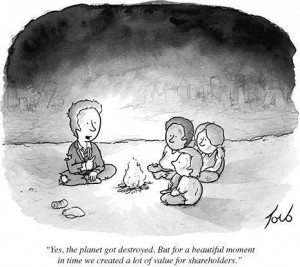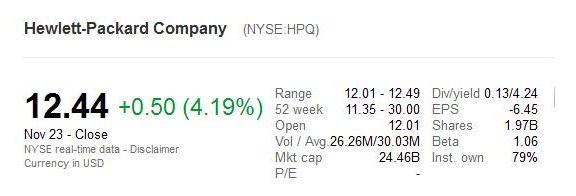The adult in the cartoon is not Carly Fiorina, Mark Hurd, Leo Apotheker formerly of HP, or John Lynch, formerly of HP & Autonomy. While the three ex-CEOs were paid a total of $80 Million after being fired (here), they did NOT create shareholder value. Under their guidance, the company lost 77.92% of its peak value; the shareholders lost $81.54 Billion between Dec. 31, 1999 (here) and the close of trading, Nov. 23, 2012.
While Autonomy’s $10 Billion valuation may have been John Lynch’s fraud – the FBI and it’s counterparts in London are investigating (here) – HP’s acquisition of Autonomy was Leo Apotheker’s error, and has become Meg Whitman’s problem. I’m sure that if Whitman is unsuccessful, or the Board fires her before she can be successful, she will be well taken care of, as were Fiorina, Hurd, and Apotheker. Meanwhile Bill Hewlett & Dave Packard – who created value for the shareholders and other stakeholders – must be turning over in their graves.
HP, with a market capitalization of $106 Billion at it’s peak, in 1999, (here) is worth $24.46 Billion today, at the close of trading on Nov. 23, 2012. This is 23.08% of the peak valuation. And that’s after Fiorina’s acquisition of Compaq in 2002, the acquisition of Palm, in 2010, and Apotheker’s acquisition of Autonomy, in 2011.
Financial Information from Finance.Google.com, obtained 11/24/12.
While it could be that HP is simply reverting to its intrinsic mean value, it’s also possible that the acquisition of Autonomy could push HP into bankruptcy. The company is booking losses of $8.8 Billion – losses that amount to 37.48% of the value of the company. It’s Return on Average Assets is -10.62. But none of it’s big acquisitions – Compaq, Palm, EDS, or Autonomy, actually helped the company. And according to Charles Arthur, at the Guardian, here, Autonomy is the tip of the iceberg. HP has deep underlying problems. It sells a lot of PCs, but it doesn’t make money on them.
IDC estimates it shipped 13.94m computers, giving an average price of $620, on which it got total profits of $309m – just $22 per PC.
But the real underlying problem at HP is a lack of focus on an effective strategy. This is what distinguishes HP from Apple and IBM. All have stumbled. Apple and IBM came back from the brink. IBM hired Lou Gerstner who, in his own words, taught the elephant to dance. Apple re-hired Steve Jobs who refocused the company. HP lost its focus on “The HP Way.”
What happened at HP became evident with the Board of Directors hiring Carly Fiorina in July, 1999 and her decision to acquire Compaq, finalized May, 2002.Fiorina was forced out in Feb, 2005, (C NET / CNN) / Wikipedia ) but that damage had been done.
At Carly-Fiorina.com people say things like,
Carly Finkorina destroyed the HPWay and stomped it with her 6 inch expensive heels. She had NO respect for Bill and Dave’s vision of a company where people would literally ache to do their best every day, because they knew the company would do its best for them. A company that built upon itself and gave back to each community.
The rationale is always the same:
- Bring in a “Miracle Worker” who can breathe new life into the company by mergers and acquisitions.
- Acquire a competitor or a company with a synergistic product mix, acquire the competitor’s customers and intellectual property.
- And Save money by eliminating redundant staff.
In practice one or more unforeseen systems problems always occur.
Morale drops as good people are designated as “redundant” and fired. An estimated 15,000 people were laid off in the HP – Compaq merger, in addition to thousands others that Fiorina fired. This is Strike 1.
Morale drops more as the people who engineer the deal are rewarded handsomely. This is Strike 2.
Morale drops below the basement as people who are left realize they carry the workload of two or three people. This is not Strike 3, This is a foul ball because morale was already in the toilet due to Strikes 1 and 2.
Strike 3 is the costs, in time and money, of attempting to merge corporate cultures and the financial benefits of the merger. These are never accurately estimated. Similarly the benefits of the merger, in terms of new earnings, Earnings per Share, Debt to Asset, and Return on Average Assets, other financial ratios and operating metrics never materialize. Sure the market capitalization increases, and the earnings may increase, but the Price / Earnings ratio can remain constant or drop. Meanwhile, the competition – Dell and IBM in the case of HP’s acquisition of Compaq – leaps forward.
Dell has its own problems, but I compared HP, IBM, TI and Apple, looking at key financial data at the close of trading on Nov. 21, 2012. These data are presented in table 1, below.
| Basic Financial Data | ||||||
| Price | Earnings per Share | Market Capitalization (Billions) |
Price Earnings | Debt to Assets | R o Avg Assets | |
| HPQ | $11.94 | – $6.46 | $23.48 | undefined | 26.14 | -10.62 |
| IBM | $190.29 | $13.89 | $215.01 | 13.7 | 26.9 | 13.79 |
| TXN | $29.2 | $1.53 | $32.73 | 19.06 | 27.28 | 13.19 |
| AAPL | $561.7 | $44.16 | $528.39 | 12.72 | 0 | 28.54 |
| Table 1. Close of trading, Nov. 21, 2012, courtesy Google / Yahoo | ||||||
The numbers speak for themselves. Apple has no debt and more than double the Return on Average Assets of IBM & Texas Instruments. Apple and IBM have similar Price Earnings ratio. HP, IBM, and TI have similar Debt to Asset ratios. These data suggest to me that it may be wise to invest in Apple and IBM.
Pratley at The Guardian sums up the Autonomy deal and the context within which it took place:
Hewlett-Packard can’t say it wasn’t warned. Autonomy, in its independent life, was a company that seemed to be in perpetual war with half the City’s analysts over accounting treatments. Even at the time of the takeover offer last year, technology specialists blogged furiously about aggressive revenue recognition, cash conversion and the like. And let’s not forget the entertaining spat between Autonomy founder Mike Lynch and Oracle’s Larry Ellison.
In short, the message to Hewlett-Packard ought to have been obvious: if you are spending $10bn (£6bn) on a company with annual sales of roughly $1bn you had better be damn sure the business is of the highest quality.
…
Remember the context here. Hewlett-Packard was a former computer titan fallen on hard times. Too many acquisitions, such as EDS and Palm, had turned sour and new-boy chief executive Léo Apotheker was desperate to find an instant fix. He decided to get out of making personal computers and buy Autonomy at an almighty takeover premium of 64%. The PC strategy was immediately reversed by Whitman, who arrived soon afterwards. But the price paid for Autonomy was otherworldly – it smacked of a management team that was too anxious to make a hardware-for-software switch.”
What’s next?
It’s a binary choice: HP will either go out of business, or return to profitability.
While Apple can buy HP for cash, and still have $100 Billion, cash, it won’t (unless Tim Cook and Apple’s Board want to re-invent HP/UX as a OS/X big-server operating system and go into the corporate space, which could be fun).
Maybe Ms. Whitman will acquire Research In Motion and that will save HP. It’s product mix is synergistic with PALM. And RIM’s shareholders, stakeholders, and managers may be dreaming about a recovery – or effectively planning one – but it doesn’t appear that they are presenting a fake set of books. But unless Ms. Whitman re-establishes the “HP Way” anything she does will at best be a stop gap measure on the long downward spiral that began 12 years ago. HP must also, obviously, sell high-margin products.
–
Neither Meg Whitman, nor any current or former employee or executive of Hewlett Packard or any other company named herein was consulted in preparation of this post.
In addition to my work at Popular Logistics, I currently serve as “Director of Information Technology” for a mid-sized law firm in lower Manhattan. In over 25 years in Information Technology, I have worked as a database administrator, backup and recovery consultant and software developer. I am available for research and analysis on a per project or a per diem basis. I would love to work at HP re-establishing the “HP Way” and implementing a strategy to develop high margin lines of products.” I don’t work miracles but I do work hard – and accomplish my goals. I hold a Bachelor’s in Biology and an MBA in “Managing for Sustainability,” from Marlboro College. I can be reached at “L Furman 97” @ G Mail . com and US 732 . 580 . 0024. I am long on Apple.

